Love Letters - A word-image project by Mithu Sen
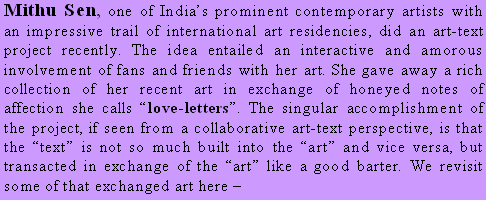

In April 2007, Mithu Sen advertised on-line a ‚Äòsummer dhamaka called the Free Mithu project, in which she invited friends, colleagues, and acquaintances to send her a ‚Äúletter with love‚Äù in exchange for a free artwork by her in a medium of their choice. For almost two years, Mithu has collected various forms of ‚Äòletters‚Äô ‚Äì including two diaries, a box of mangoes, a sweater, the dictation of a letter, a conversation shared over lemon cake, and works of art ‚Äì from a wide range of participants across the world. Through interactions with these contributors, ‚ÄúFree Mithu‚Äù has become part of a personal journey that explores the fragile notions of sincerity, generosity, and gift-giving in relation to Mithu‚Äôs art practice and a broader contemporary market-driven art culture.]¬ As "Free Mithu" began to take shape as an event, exhibition, and performance that went beyond the boundaries of on-line space, the complexity and overflowing contradictions of the project ‚Äì which attends to the psychological and emotional depth of the over-100 participants besides the artist - came clearly into focus, and lent additional challenges to how the project could be presented and contextualized. It seemed desirable that the project is described with its unresolved complications, true to the interactions and ideas generated from within. And so, I am presenting¬ parts of correspondences between Mithu and me, my reactions, and understanding of this project ‚Äì excerpted from our exchanges and friendship ‚Äì to ‚ÄúFree Mithu.‚Äù -Beth Citron¬ [Is Mithu Giving "Free" Art?]¬ There is an old clich√©¬ that 'nothing in life is free.' When an artist advertises 'free' artwork, many people assume it is insincere or a joke or that there must be a catch ‚Äì especially when it is advertised on-line, in the midst of a hot and frenzied art market, and when the artist in question is known to be whimsical and a bit romantic, though by all accounts unusually generous. Mithu Sen had asked those invited simply to send her a "letter with love" and register on-line at her website (www.mithusen.com) to confirm their participation in this project. This implied some amount of exchange, though clearly getting an original artwork in return for a letter would still be a good deal by most people's standards. But what transpired was much bigger and more subtle than the initial proposal would have indicated ‚Äì a series of emotional, psychological, conceptual, intellectual, and material exchanges that became a chronicle of those who wove into Mithu's life during the almost two years of the project.¬ In the outpouring of individual letters, artworks, sentimental objects, gestures, and love sent to Mithu, it became clear that nothing would be given away for "free," in the sense of free being gratuitous or at no value. Instead, the transactions between Mithu and her participants already contained everything of worth ‚Äì beauty, sincerity, truth, life, love, art, warmth, sweaters,¬ sarees, and mangoes or¬ lemon cake¬ ‚Äì each metaphoric of an individual interaction and relationship.¬ MS: is it love for art/me or it is the market/commerce? BC: well, i feel - in general, but not specifically, some interactions may be different - that [some] people are really getting a "free" work. MS: i question ...how art reach to the heart...¬ ¬ [ What Mithu Received]¬ Many participants sent conventional letters, as the project demanded, ranging from a simple postcard note to detailed, rich, and creative correspondences filled with hours of thoughts and words. Some sent multiple letters over the course of the project¬ (or continued a participant‚Äôs practice to write a letter to Mithu every few weeks, from anywhere in the world),¬ and two people sent their own diaries to Mithu¬ (one is filled with memories, and one is half finished with a request to complete the rest of the pages with love.). Each evoked the nature of an individual relationship or moment with Mithu, and sincerely set forth what a participant was able to give to this project. Alongside these were many other alternative forms of "letters," which often represented specific participants' values or personal ways of giving. For example, one very busy man in Delhi insisted on giving his time to Mithu and dictate his¬ love/letter in person. He wished that she write down his words herself, as he did not want any essence of what he was sharing to disintegrate in the mail. Others were interested in giving time back to Mithu through their letters. One artist sent a letter and said that instead of Mithu gifting a work to her, to please spend that amount of time resting¬ as Mithu fallen sick for few months last year. And a woman in Delhi, concerned that Mithu was working too hard and under too much stress, required that Mithu pick up her letter herself, so that they might spend a few relaxed hours talking and sharing a lemon cake¬ on her terrace garden.¬ A lonely man simply approached her to walk few steps together when he goes for an evening walk.¬ And a stubborn writer friend wrote a long love letter with lots of fantasies and passion spending many hours on the text sent by e-mail, but never agreed to send the same by post! Of the types of letters given to Mithu, many artists chose to create and send her one of their own artworks, as a gesture of expression from their usual languages. This created a conceptual exchange that might have a different edge from the other types of contributions. Of course, these artists are simply doing what is natural for them to do - communicating how they communicate, giving how they give. Are they not also bartering their work for Mithu's on a one-to-one basis? This is not just commercial, though there may be a material/economic equality in these exchanges. There is also the sensitive intention to create an equal emotional debt, possible because artists understand the 'real value' of their works and the meaning of parting with them. Though these works were sent to Mithu personally, they are displayed among the other letters as part of "Free Mithu" at Khoj, to be shared with the public as part of what will become a shared exhibition. In fact, as the artworks Mithu makes will be giftwrapped and not seen directly, but those by other artists ‚Äì as¬ letter senders/contributors¬ - will be, it will seem to be an inadvertent exhibition of their art installed by Mithu as a ‚Äúletter with love‚Äù‚Ķ¬ Perhaps as interesting are the vocal ways in which people chose¬ not¬ to participate, whether a gallerist refusing because of his sincere concern that the project might devalue Mithu's work, the ongoing promise of many would-be participants to send letters that never arrived, offense, reluctance because people seemed unsure of whether their works would ever be delivered, uncertainty of what to send, a collector's choice to purchase¬ the¬ Mithu Sen work that she had been coveting instead of being gifted another work, or a lack of urgency to acquire Mithu's work for "free" once the art market started to fall. ¬ ‚Ä®¬ [And What Mithu is Giving] [¬ MS: a GIFT is a GIFT is a GIFT for ever‚Ķ¬ This project is thinking of those friends who cannot AFFORD an artwork they truly desire‚Ķ.and here the definition of 'afford' goes beyond purchasing power, market or mediator ‚Ķ.it could be anything‚Ķ.time, gratitude, love, respect, care, sincerity, passion, bondage‚Ķ.. ....money can only get out of a relationship by pricing it as a commodity.......when we give or receive a gift it shows our personal bond, care and relationship between us.....gifts establish a feeling, a bond between two people. This bond may not be social....it could be spiritual or psychological as well. ¬ ¬ ‚ÄúFree Mithu‚Äù relies intrinsically on the concept of a ‚Äúgift,‚Äù meaning the giving of something of worth beyond the plain commercial value of the object. Mithu and I both read ‚ÄúThe Gift‚Äù by Lewis Hyde, to gain certain conceptual and theoretical insights about what we were already talking about. With no expertise in economics or psychology, I found Hyde‚Äôs examples of ‚Äúgift economies‚Äù informative and educational, but not expressly applicable to the essence of the very individual interactions in this dialogue. However, I was completely taken up with the idea of a ‚Äútransformative gift,‚Äù in which the gift changes its recipient profoundly over time, often in the form of psychological healing or teaching. The transformative gift requires the recipients to undertake significant work on themselves ‚Äì and this is most often done out of a feeling of love or gratitude to the giver.¬ This is the true gift, and it remains to be seen as an afterward how many of those will result from ‚ÄúFree Mithu.‚Äù¬ Mithu Sen: ...so? how to start... with love? free...?¬ ¬ Beth Citron: sooooo yes, start with love but how do you feel about all the recent letters youre getting? and making the works now to give away?¬ MS: hey......its important... its strange.. sometime am feeling to give whatever i have with me... at the same time my rational mind stopping me becoming bit conscious so am trying to balance also not to do injustice to my friends/applicants¬ The artworks that Mithu will gift through this project are mostly traditional "Mithu Sens," meaning mostly the drawings for which she is best known as an artist (over the course of the project, the ‚Äòdemand statistics‚Äô from mithu's eight options confirm that drawings are the most popular medium of choice; Mithu actually wanted to follow this up with a graph of that tabulates market, demand, and public psychology). While the project overall is experimental and radical, these works are intentionally not, as they are metaphors of the exchange and connections between the artist and participants. It is also at heart a psychological game, in which Mithu must figure out what to give to each participant, to discover their desire and need, and attend to whatever they may have asked her for ‚Äì directly or inadvertently. ¬ ¬ ¬ Boldly, courageously, Mithu is also hosting a ‚Äúlottery‚Äù of four large-scale multimedia drawings that will be exhibited at Khoj. All of the participants who registered and submitted a letter for ‚ÄúFree Mithu‚Äù will be eligible for the lottery, meaning that through the luck of the draw, the winners could be a wealthy acquaintance who sent a brief note or a young student in Bengal who saved up all of his money expressly to buy a work by Mithu and asked her what kind of her work he could get for his savings of 30,000 rupees. In contrast to the equilibrium that Mithu can attempt to create through the individual gifted artworks, the lottery forces her to give up control, to let go of her work, and rely on luck and chance to intervene in where her large drawings land. In ‚ÄúFree Mithu‚Äù as in life, it‚Äôs good to be lucky and realize how much remains up to chance.¬ ¬ ¬ [New Section ‚Äì my participation]¬ ¬ I entered this project as a participant in October 2007, as Mithu and I had gotten to know each other more closely during her stay in New York for her ‚ÄúHalf Full‚Äù show the previous month. During a shared day at Brandeis University in Massachusetts, she told me about ‚ÄúFree Mithu‚Äù and said that she would like to gift a work to me if I would send her one ‚Äòletter with love.‚Äô She also told me that she liked the simple black cardigan sweater I was wearing, and we made plans to go shopping together to buy one for her when she got back to New York and had some free time. As our shopping date never took place, I thought to send her my sweater ‚Äì along with a few spare words ‚Äì as my warm letter (with love) and contribution to ‚ÄúFree Mithu.‚Äù This began a still-ongoing informal dialogue between Mithu and me about her art, generosity, ‚ÄúThe Gift‚Äù by Lewis Hyde, gifts, the concept of ‚Äòfree,‚Äô Shah Rukh Khan, love, attachment, curtain repair, visual icons, airfares, waterproof boots, private and public gestures, hospitality, and many other hopelessly complicated and hopefully irreconcilable topics.¬ Mithu then asked me in summer 2008 to contribute some words to the public life this project, and the text presented here results from our exchanges and interaction about ‚ÄúFree Mithu.‚Äù¬ ¬
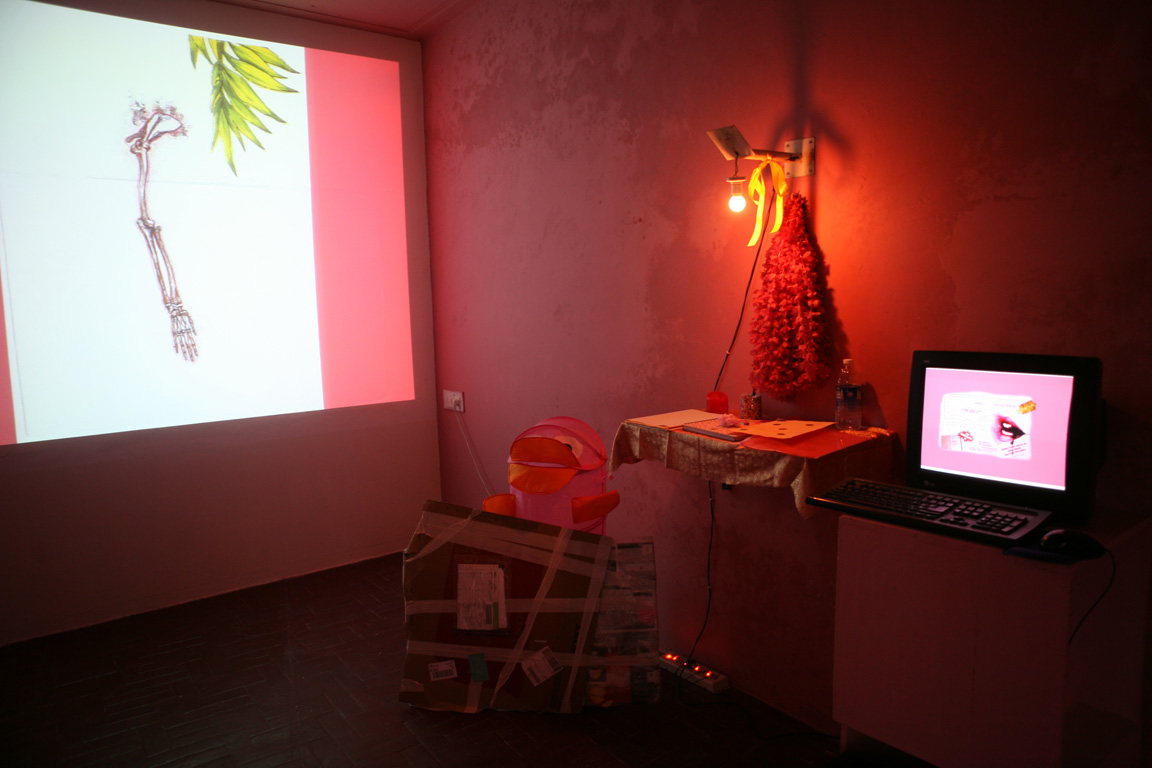
|
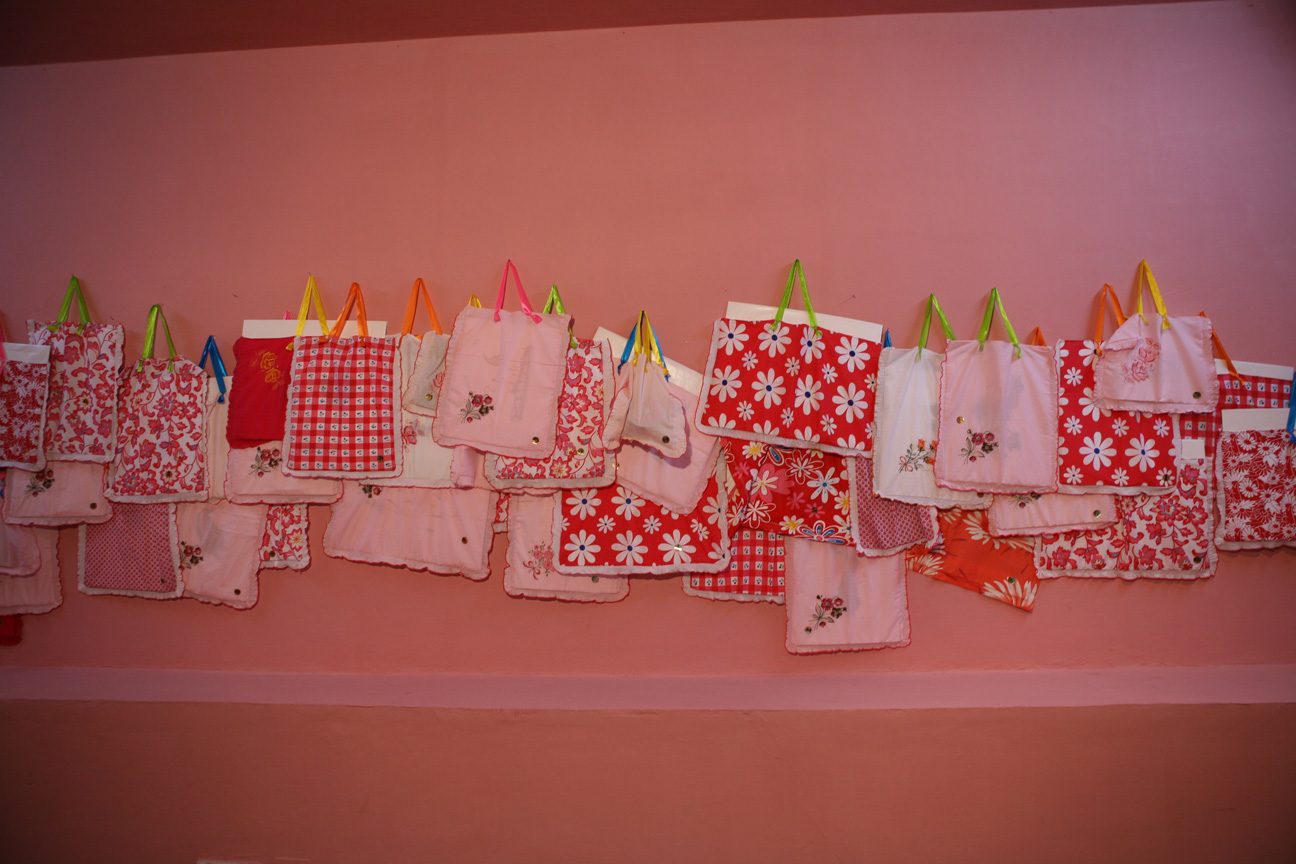
|
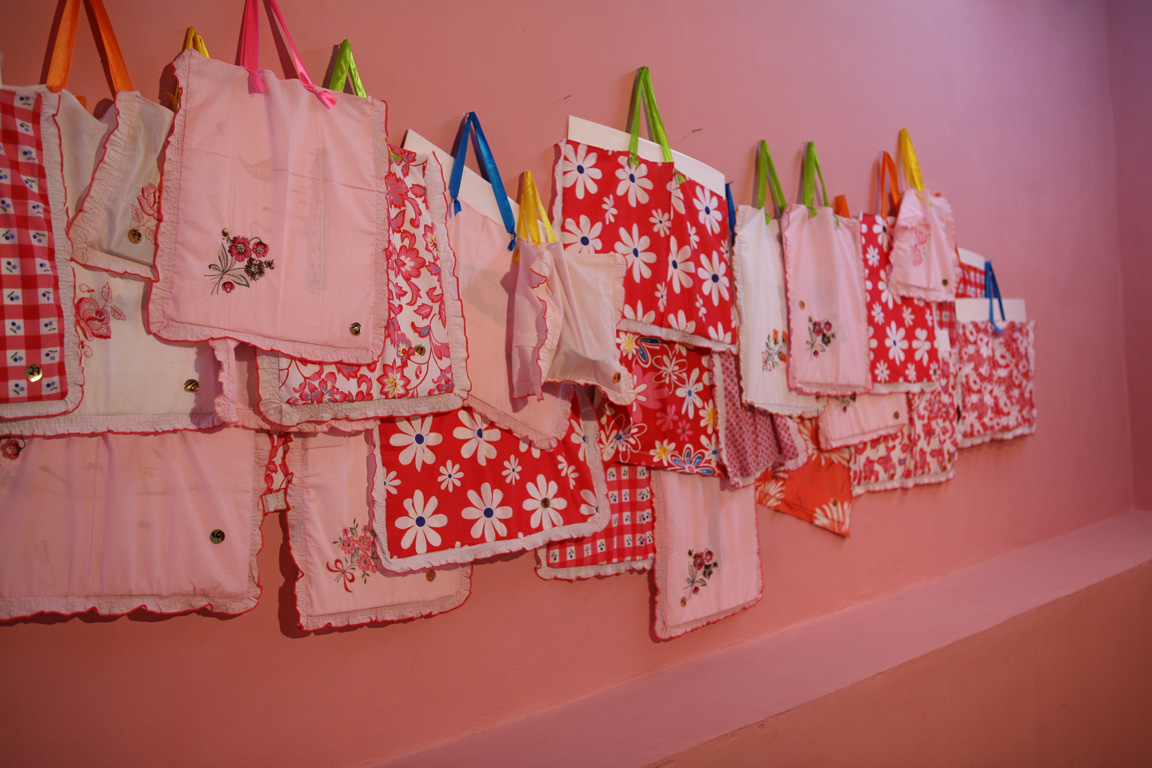
|
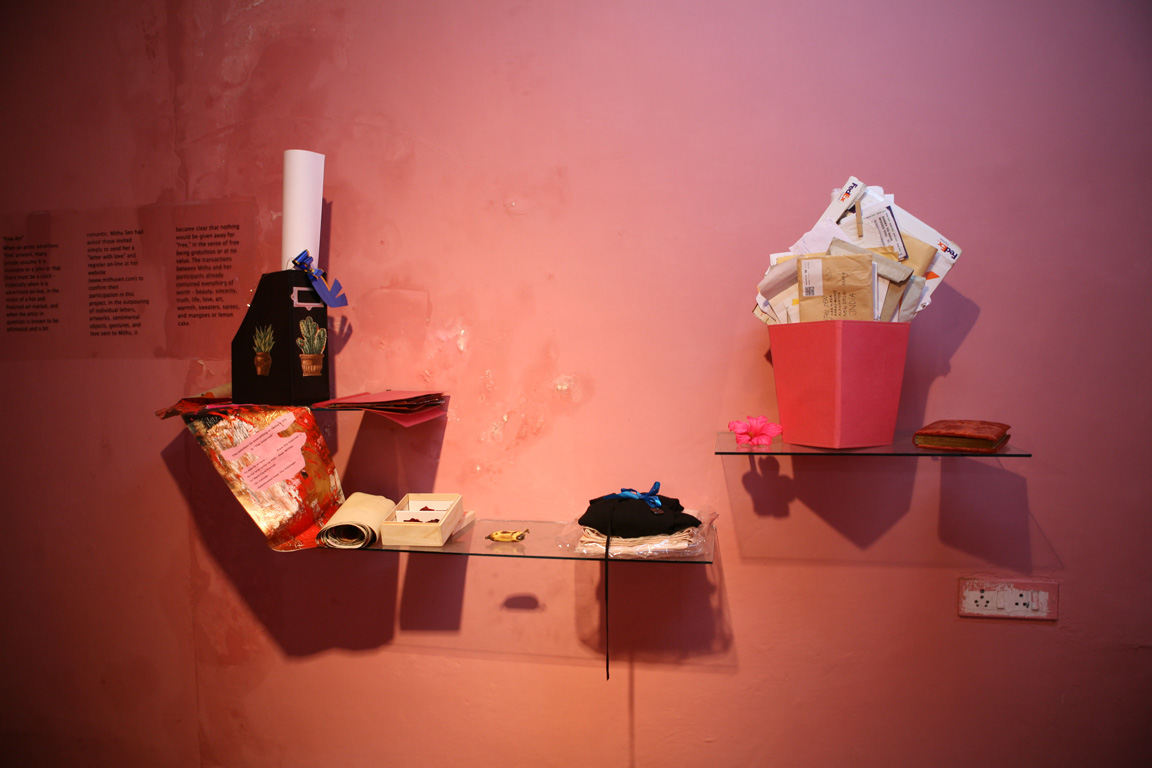
|
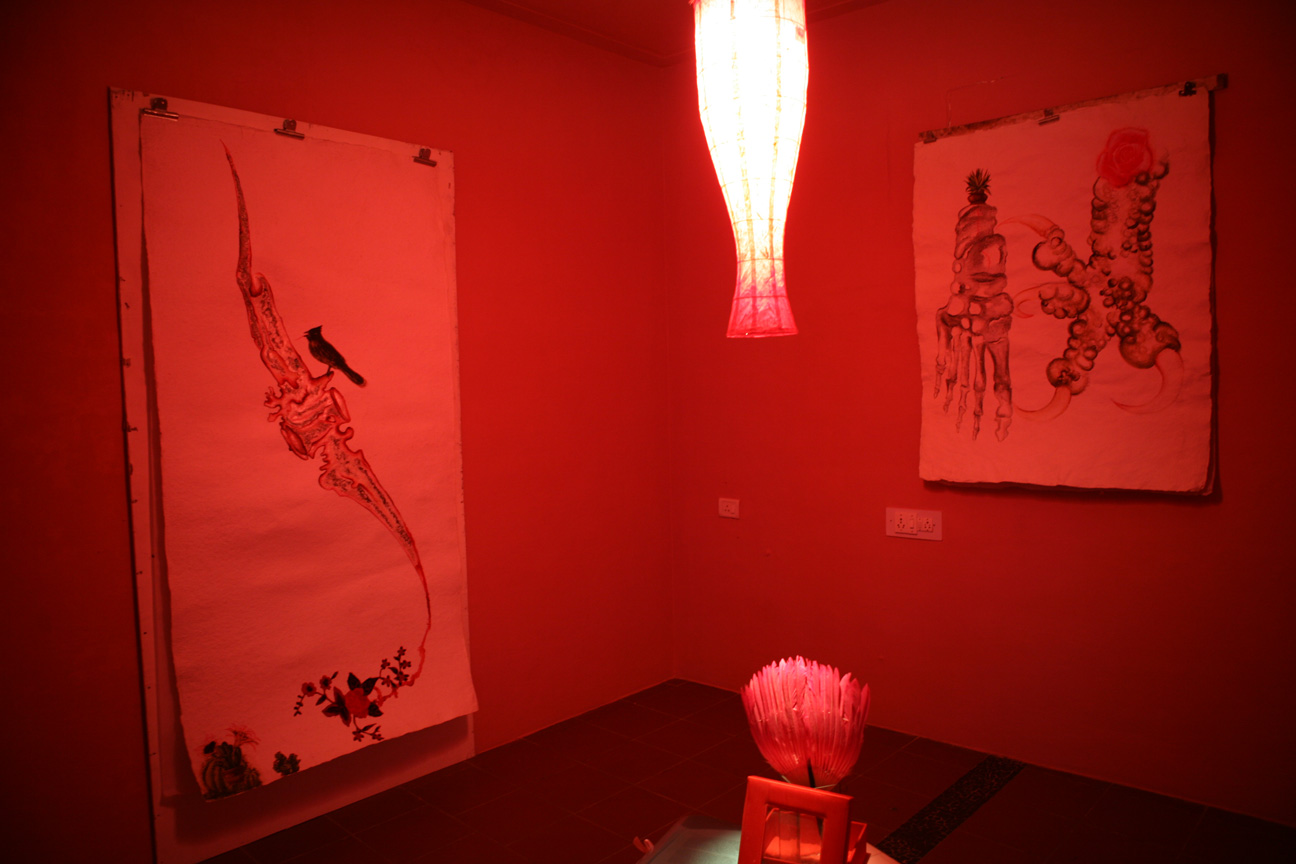
|
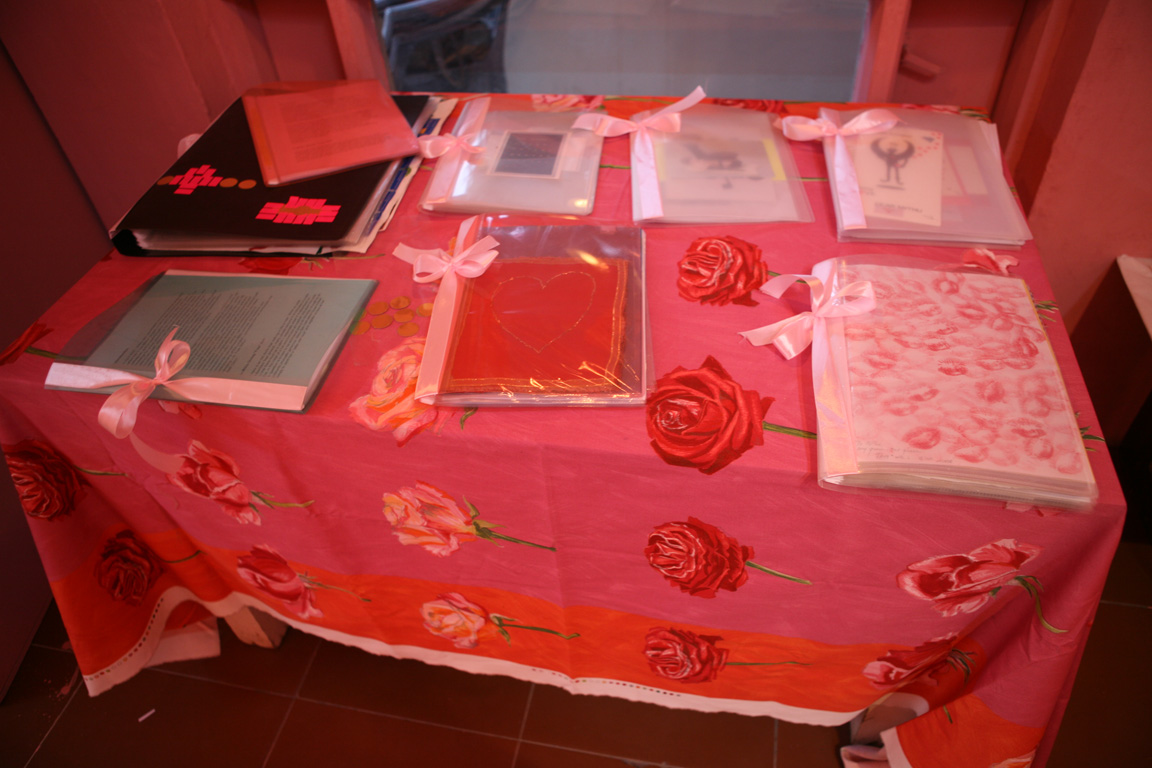
|

|
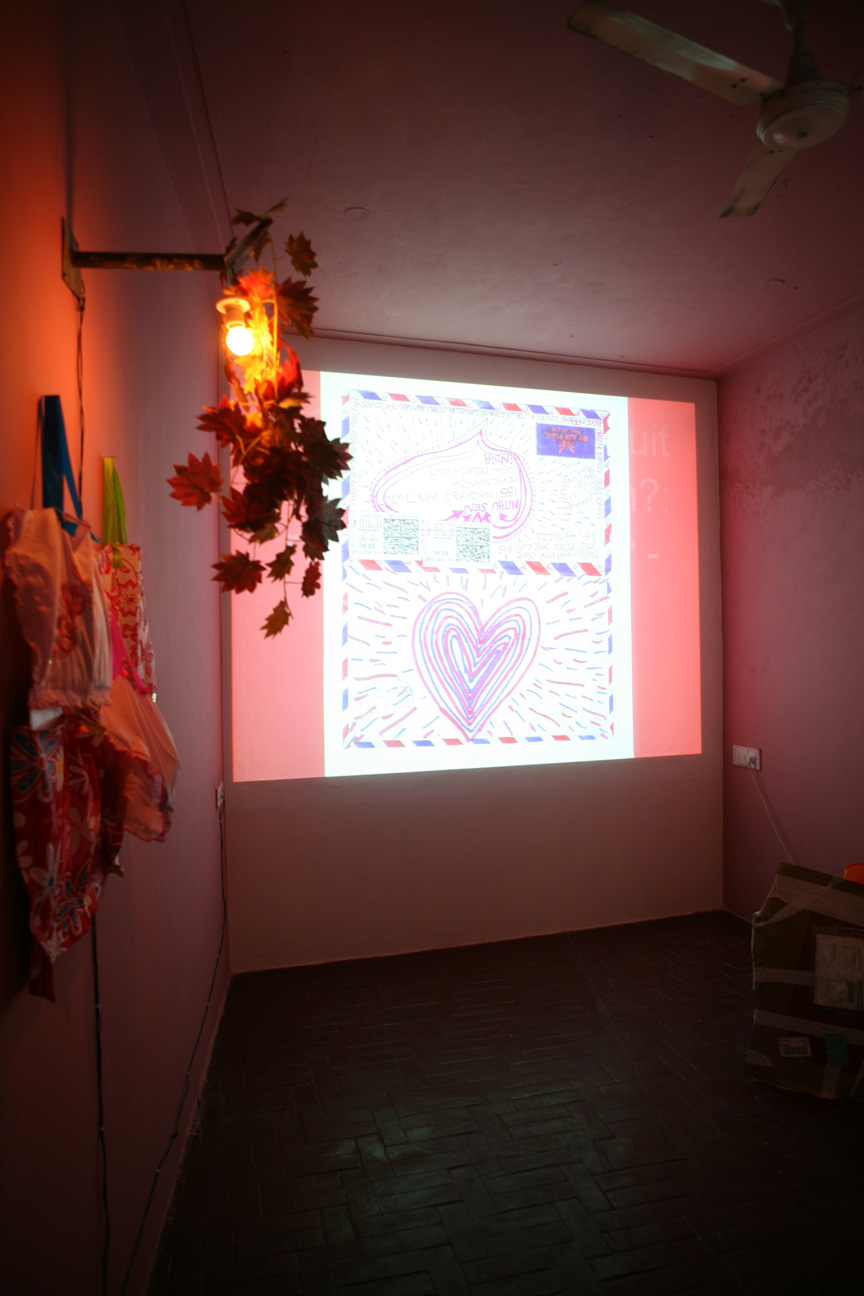
|